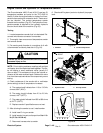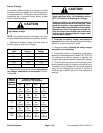
Groundsmaster 4000--D/4010--DPage 5 -- 48Electrical System
Battery Service
The battery is the heart of the electrical system. With
regular and properservice, battery lifecan be extended.
Additionally, battery and electrical component failure
can be prevented.
CAUTION
When working with batteries, use extreme cau-
tion to avoid splashing or spilling electrolyte.
Electrolyte can destroy clothing andburn skin or
eyes. Always wear safety goggles and a face
shield when working with batteries.
Electrolyte Specific Gravity
Fully charged: 1.265 corrected to 80
o
F(27
o
C)
Discharged: less than 1.240
Battery Specifications
BCI Group Size 34
690 CCA at 0
o
F(--18
o
C)
110 minutes reserve capacity at 80
o
F(27
o
C)
Dimensions (including terminal posts and
caps)
Length 10.2 inches (259 mm)
Width 6.6 inches (167 mm)
Height 8.0 inches (203 mm)
Battery Removal and Installation (Fig. 65)
1. Raise and support operator seat. Remove battery
access panel.
2. Loosen and remove negative cable from battery. Af-
ter negative cable is removed, loosen and remove posi-
tive cable.
3. Loosen battery strap that secures battery to ma-
chine.
4. Carefully remove battery from machine.
5. Install battery in reverse order making sure to con-
nect and tighten positive cable to battery before con-
necting negative cable.
NOTE: Before connecting the negative (ground) cable
to the battery, connect a digital multimeter (set to DC
amps) between the negative battery post and the nega-
tive (ground) cable connector. The reading should be
less than 0.1 amp. If the reading is 0.1 amp or more, the
machine’s electrical system should be tested for short
circuits or faulty components and repaired.
6. Secure battery with battery strap. Install battery ac-
cess panel. Lower and secure operator seat.
1. Negative cable
2. Positive cable
3. Battery strap
Figure 65
1
2
3
Battery Inspection and Maintenance
1. Perform following inspections and maintenance:
A. Check battery for cracks. Replace battery if
cracked or leaking.
B. Check battery terminal posts for corrosion. Use
wire brush to clean corrosion from posts.
IMPORTANT: Before cleaning the battery, tape
or block vent holes to the filler caps and make
sure the caps are on tightly.
C. Check for signs of wetness or leakage on the top
of the battery which mightindicate a loose ormissing
filler cap, overcharging, loose terminal post or over-
filling. Also, check battery case for dirt and oil. Clean
the battery with a solution of baking soda and water,
then rinse it with clean water.
D. Check that the cover seal is not broken away. Re-
place the battery if the seal is broken or leaking.
E. Check the electrolyte levelin each cell. Ifthe level
is below the tops of the plates in any cell, fill all c ells
with distilled waterbetween the minimum andmaxi-
mum filllines.Charge at 15 to 25 amps for fifteen(15)
minutes to allow sufficient mixing of the electrolyte.


















